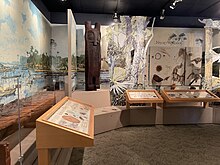Timucuan Ecological and Historic Preserve
| Timucuan Ecological and Historic Preserve | |
|---|---|
 Salt marsh at Timucuan | |
| Location | Jacksonville, Florida, United States |
| Nearest city | Jacksonville, Florida |
| Coordinates | 30°27′16″N 81°27′00″W / 30.45445°N 81.44988°W |
| Area | 46,000 acres (190 km2) |
| Established | February 16, 1988 |
| Visitors | 1,102,223 (in 2022)[1] |
| Governing body | National Park Service in cooperation with other agencies |
| Website | Timucuan Ecological and Historic Preserve |
Timucuan Ecological and Historic Preserve | |
| Location | 13165 Mt. Pleasant Rd., Jacksonville, Florida |
| Area | 46,000 acres (19,000 ha) |
| NRHP reference No. | 01000283[2] |
| Added to NRHP | February 16, 1988 |
The Timucuan Ecological and Historic Preserve is a U.S.
The preserve was established in 1988 and expanded in 1999 by Preservation Project Jacksonville.
Background
The
They also have excavated more recent artifacts contemporary with the
Archeologists believe they have found evidence of a
On June 9, 2020, the Preserve gained another 2,500 acres of marshland along the Nassau River from two private land trusts.[4]
Trails
Several trails allow the public to explore the natural habitats protected at the preserve.[5][6]
- Fort Caroline National Memorial
- Hammock Trail
- Spanish Pond[7]
- Theodore Roosevelt Area
- Timucuan Trail
- Willie Browne Trail with bird observation platform[8]
- Cedar Point
- Cedar Point Loop Trail
- Pinelands Trail
- Fort George Island
- Saturiwa Trail[9]
- Big Talbot Island State Park
- Shoreline Trail
-
Sign at Spanish Pond
-
Brown anole at Spanish Pond
Visitor Center

The Timucuan Preserve Visitor Center is located near the Fort Caroline National Monument. An exhibit called “Where the Waters Meet: The Ecology and History of the Timucuan Preserve” presents several panels of diagrams, illustrations, timelines, and information. The free exhibit collection includes artifacts as well as replicas of tools, weapons, and the materials used to create them, such as shells and tree fibers.[10]
The Preserve hosts “Artist in Residence” programs annually, allowing local artists to live at the Kingsley Plantation for two- to six-week periods, during which time the artist(s) create original works of art influenced by the area.[11] Some of these works are then displayed in the visitor center at the end of the residency.[12]
Community events hosted by the Preserve include “Artist in Residence,” Pop-Up Ranger talks, group hikes, and Junior Ranger activities.[13]
See also
- Big Talbot Island State Park
- Fort George Island Cultural State Park
- Little Talbot Island State Park
- Kingsley Plantation
References
- ^ "Annual Park Ranking Report for Recreation Visits in: 2022". Retrieved July 25, 2023.
- ^ "National Register Information System". National Register of Historic Places. National Park Service. July 9, 2010.
- ^ a b c Matt Soergel, "Archaeologists help distinguish Mocama group", Morris News Service, 25 Oct 2009, accessed 11 May 2010
- ^ "Land Trust sells 2,500 acres of Nassau River marsh to National Park Service". WJXT. June 9, 2020. Archived from the original on August 19, 2022. Retrieved 10 June 2022.
- ^ "Plan Your Visit". National Park Service.
- ^ "Timucuan Ecological and Historic Preserve HIKING TRAILS". National Park Planner.
- ^ "Spanish Pond". National Park Service.
- ^ "Bird Platform". National Park Service.
- ^ "Saturiwa Trail". National Park Service.
- ^ "Timucuan Preserve Visitor Center - Timucuan Ecological & Historic Preserve (U.S. National Park Service)". www.nps.gov. Timucuan Preserve Visitor.
- ^ "Artist In Residence - Timucuan Ecological & Historic Preserve (U.S. National Park Service)". www.nps.gov.
- ^ "Artist In Residence - Timucuan Ecological & Historic Preserve (U.S. National Park Service)". www.nps.gov.
- ^ "Be A Junior Ranger - Timucuan Ecological & Historic Preserve (U.S. National Park Service)". www.nps.gov.
External links
![]() Media related to Timucuan Ecological and Historic Preserve at Wikimedia Commons
Media related to Timucuan Ecological and Historic Preserve at Wikimedia Commons
- Timucuan Ecological and Historic Preserve, National Park Service
- Timucuan Ecological and Historical Preserve: Water Resources Management Plan (November 1996, 160 pages)







